RIGHT TURN ONLY!!
A Multitude of Angels
by Carlo Santos,

It's election day in America! This column still endorses Bandit Keith as the candidate of choice, even though Yu-Gi-Oh! parody jokes have pretty much died of old age. But I stand by my endorsement, because there will never, ever be a U.S. president as cool as a guy who wears an American flag on his head.
ANGELIC LAYER
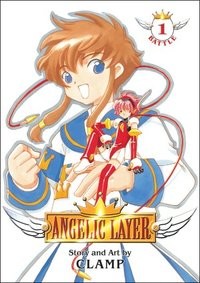
Vol. 1 Omnibus
(by CLAMP, Dark Horse Comics, $19.99)
FROM THE BACK COVER:
"Junior-high student Misaki Suzuhara has just arrived in Tokyo to live with her glamorous TV news star aunt and to attend the prestigious Eriol Academy. But what excites her above everything is Angelic Layer, the arena game where you control an 'Angel'—a miniature robot fighter whose moves depend on your mind! Misaki's small, just like her Angel, Hikaru (named after Magic Knight Rayearth), but her natural battle skills gave been recognized by a very odd scientist, Ichiro 'Icchan' Mihara. Before she knows it, Misaki is an up-and-coming contender in Angelic Layer ... and way in over her not-very-tall head!"
EVIDENCE FOR:
It's over a decade old, and the "dueling toys/cards" craze isn't really a big deal anymore, but Angelic Layer still stands As One of CLAMP's most enjoyable (and overlooked) works. This series polishes the genre to near perfection, with a cheerful-but-not-cloying lead character, mischievous yet supportive sidekicks, and a fighting system that's complex enough to be interesting, but avoids ridiculous rules or jargon. Each of Misaki's opponents offers a different fighting style, but the really neat part is how she observes and analyzes them, then uses that knowledge to win. That's more rewarding than just yelling out attacks to raise your power level. Subtle hints about Misaki's greater purpose, and behind-the-scenes intrigue involving Icchan, also add another dimension to the story. Still, the main draw of Angelic Layer is the stylishness of the fighting moves, which combine martial arts and high tech in stunning, action-packed shots. Angled panel layouts and heavily speedlined backgrounds make every fight scene as kinetic as possible, and the energy carries over to the characters' day-to-day lives, with their exaggerated poses and humorous pratfalls. Of all the magical and sci-fi battle manga out there, Angelic Layer exudes more fun than any other.
EVIDENCE AGAINST:
The beauty of Angelic Layer is in its simplicity. But is it too simple? The entire story of this volume is that Misaki learns what Angelic Layer is, then starts mowing down opponents left and right. The move from training room to tournament arena is too rushed, and the improbable underdog story is as predictable as they come—if this were an anonymous artist's work being submitted to an editor, it'd probably be rejected. When the series does try to add more depth to the story, it does so timidly: the subtle (but guessable) clues about what Icchan is trying to accomplish are brushed away before there's any chance to dig deeper. A few casual attempts to bring romance into Misaki's life also end up going nowhere, while the supporting characters who might have interesting back-stories—like Icchan's little brother—don't get the attention they deserve. The art has some missteps as well: it tries too hard to be funny with chibi designs and super-stretched characters during dialogue scenes, and some pages feel incomplete with a lack of detail in the backgrounds.
FINAL VERDICT:
It's pure Angel-battling fun from start to finish. Some may see the straightforward tournament format as a flaw, but I see it as a way of taking the simplest idea and crafting A grade material out of it.
BLUE EXORCIST
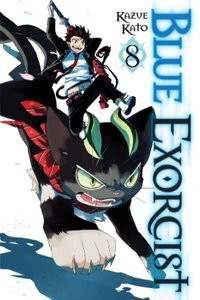
Vol. 8
(by Kazue Katō, Viz Media, $9.99)
FROM THE BACK COVER:
"Awakened by the traitor, Saburota Todo, the Impure King's massive form threatens to engulf the city of Kyoto. As the Exorcists of the Tokyo Branch and the monks of the Myodha Temple do all they can to contain the demon, Rin and his friends find themselves separated and facing their own battles. While Rin and Ryuji race to confront the full might of the Impure King, Yukio takes on Todo single-handed and discovers that he may be his own worst enemy!"
EVIDENCE FOR:
Volume 8 of Blue Exorcist pulls out all the stops to remind us of a universal truth: great heroes, when pushed to their limits, can tap into reserves of power they never even knew they had. Yes, this long-running battle arc is all about facing death ... then turning it away with incredible feats of magic. It's not just limited to Rin's trademark Blue Flames or Yukio's sharpshooting, either—all the exorcists get a chance to shine, from Suguro's awe-inspiring flame barrier, to Shiemi's herbal healing, to beast-summoning and incantations and magical glowing weaponry. It may sound cheesy and excessive, but just wait until you see it in action: this is one series where the artwork does match up to the creator's ambitions. Kazue Katō takes no shortcuts in rendering the giant spore-cloud that threatens to smother Kyoto, and art lovers will appreciate the careful shading and details along with the page-spanning sense of scale. The exorcists and their attacks also fill every scene with otherworldly visuals and eye-popping excitement. One Last Note, though: impressive as the battle is, it's Yukio's flashbacks, and his personal battle with himself, that truly make this volume complete.
EVIDENCE AGAINST:
Everyone shows off their skills individually, but string it all together, and what do you get? A mess. Much of this volume is a battle on multiple fronts, and trying to get a cohesive storyline out of that is like trying to solve a Rubik's Cube where someone's scrambled the stickers. The plot jumps around wildly, from Rin and Suguro's battle, to Yukio's one-on-one showdown, to the girls taking care of Suguro's dad, to local monks trying to keep it together. What's the focus point here? How does one scene connect to another? Only after characters join up with each other, and others are eliminated, does it start to make sense. Even then, some of the battle scenes continue to be an unsolvable puzzle: when the local monks come to Yukio's aid, all they seem to do is jump around and scream incantations, making it more confusing than when he was fighting alone. And Rin's battle against the Impure King, which should have been the focal point all this time, never really takes off until the last chapter because his storyline keeps getting interrupted by everything else that's going on.
FINAL VERDICT:
Confusing as it can be, there's no denying the visual and emotional impact of this life-or-death battle. Blue Exorcist still stands out in the action-adventure genre, enough to pick up a B.
HEROMAN
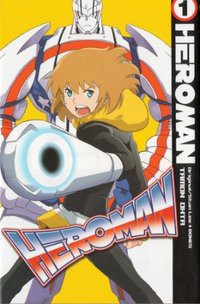
Vol. 1
(by Stan Lee, BONES and Tamon Ohta, Vertical, $10.95)
FROM THE BACK COVER:
"Like most teens at Central City Middle School, Joey Jones is in desperate need of a hero. But the hero of his desire isn't someone in tights; instead it's the latest technological fad, a remote-controlled bot called the Heybo. Without much in terms of savings, Joey's Little Hero seems out of reach, but in a twist of fate not only does he come to possess one of these machines, but his new HeroMan comes to life to help him save the Earth from alien invasion!"
EVIDENCE FOR:
It's retro, it's modern, it's HeroMan! Although only a couple of years old, HeroMan harkens back to the distant age of super robots, when mechas were sentient and godlike. Indeed, HeroMan seems to run on both science and magic, and the way he battles with raw physical strength is refreshingly old-school. Even HeroMan's appearance has a throwback appeal to it—with a stocky body and thick arms like that, you just know he doesn't need fancy physics explanations to work. The human characters are also distinctively designed, with faces and body types that make their roles instantly identifiable: the humble boy hero, the entitled jock, the wacky mad scientist, and so on. Speaking of boy heroes, Joey strikes an ideal balance as the protagonist—a quiet underdog most of the time, but also a guy who can step forward with that courageous sense of justice. However, inner qualities are only half the equation, and it's the bombastic, bone-crushing fights that leave the strongest impression. Volume 1 doesn't waste any time with cupcake opponents; Joey and HeroMan basically save the world at least twice and look seriously cool while doing it.
EVIDENCE AGAINST:
Much as I respect Stan Lee for his contributions to comic book history, he really needs to quit his racket of handing out half-baked ideas for other artists to finish. There's no nuance to the good-versus-evil conflict in HeroMan; Joey is embarrassingly pure-hearted, and the villains are of the mindless "let's do evil things for the sake of being evil" variety. This also leads to the inevitable monster-of-the-week setup where Joey battles exactly one bad guy every chapter, and he might muse upon his purpose in life if we're lucky. The fights aren't even executed that well: the art gets so overloaded that it becomes a chore just to understand what's happening, and a lack of visual contrast between heroes and villains also adds to the problem. If a poor story and poor fight scenes aren't bad enough, the setting itself is also hilariously bad: the series takes place in an all-purpose American town, which is so unrealistic that even Archie comics would sneer down on it. Cheerleaders, palm trees, school cliques! Well, everything else is already so far-fetched, so why not a fake Disney Channel-esque setting?
FINAL VERDICT:
A valiant attempt at capturing the thrill of super robot battles, but the weak storyline and confusing fight scenes average this out to a C.
NEON GENESIS EVANGELION (3-in-1 Edition)
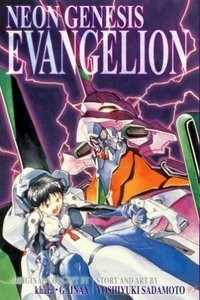
Vol. 1
(by Yoshiyuki Sadamoto, original concept by Khara • GAINAX, Viz Media, $19.99)
FROM THE BACK COVER:
"Once Shinji didn't care about anything; then he found people to fight for—only to learn that he couldn't protect them, or keep those he let into his heart from going away. As mankind tilts on the brink of the apocalyptic Third Impact, human feelings are fault lines leading to destruction and just maybe, redemption and rebirth.
The manga adaptation of the landmark animated series that changed the mecha genre. Each volume contains three of the original graphic novels and includes pages of stunning, full-color art."
EVIDENCE FOR:
After years of Evangelion spinoffs and parodies getting licensed, it feels so good to revisit the one that counts: Yoshiyuki Sadamoto's canonical manga. As the original character designer, Sadamoto ought to know the cast of Eva as well as anyone. Naturally, Shinji is still a sniveling, undeserving robot pilot, but here his rebellious streak also runs strong—proof of his potential inner strength, if only he could control it. Unexpected personality contrasts are also part of the supporting cast: flashes of human kindness from aloof father Gendo, level-headedness and flakiness forever flip-flopping in commanding officer Misato, and towards the end, just a shade of sympathy and vulnerability from the mysterious, deadpan Rei. The high-tech exterior of Eva is just as compelling as the drama within, from the fearsome mecha designs (which could easily pass for monsters instead of world-saving robots), to the unimaginably powerful Angels they have to fight, to the surreal cityscapes of 2015. Sadamoto's raw, dynamic linework fills each battle scene with earth-shattering intensity, yet the art is also delicate enough to bring out the complex emotions of quieter moments. How funny that a giant robot masterpiece can be, well, downright human.
EVIDENCE AGAINST:
Innovative as it was for the time, the first three volumes of Evangelion still feel like they're blindly going through the motions. The initial step of Shinji getting into the robot, trying to pilot it, and miraculously surviving his first mission will surprise absolutely no one. And the one thing that the series does differently from its kin—Shinji's constant monologues of "Why do I fight?", and his crushing sense of self-doubt—is repeated to the point where it starts to get a tad annoying. The occasional attempts at humor also strike a hollow chord here, as the series starts off dramatic and dark and at some point segues into Household Hijinks With Misato, or even brief bouts of fanservice, which disrupt the tone of the story. Meanwhile, the early chapters make the mistake of throwing around a lot of technobabble, and the fight scenes add another source of confusion with special effects and speedlines sometimes overshadowing the combatants themselves. You just want to see an Eva beat up an Angel, but they have to take it from the most awkward angle possible.
FINAL VERDICT:
One of the all-time greats, but it has ways to go before it hits its stride. Still, the solid characters and premise, plus intense battle scenes, make this volume worth a B+.
TRIAGE X
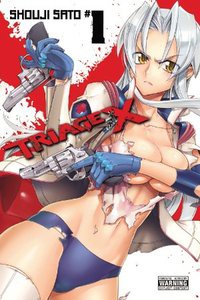
Vol. 1
(by Shouji Sato, Yen Press, $13.99)
FROM THE BACK COVER:
"Mochizuki General Hospital boasts some of the most well-trained (and well-endowed) nurses in town. But though these ladies spend much of their day battling sickness, their after-hours are spent fighting a very different sort of disease ... Under the leadership of the hospital director, a handful of staff members and local teenagers form a group of mercenary assassins, targeting the 'cancers' of society and excising those individuals before their wickedness spreads."
EVIDENCE FOR:
Triage Xbrings together all the best (and craziest) things to come out of the action genre: girls with guns, black-clad motorcyclists, butt-kicking idol singers, and a rich old guy with a sense of vigilante justice. Then it throws this motley crew of characters up against a love-to-hate-'em cast of villains: fat-cat businessmen unaware that they're about to pay for their crimes, seedy gangsters holed up in secluded buildings, and arrogant kidnappers who barely stand a chance. The resulting shootouts are where Triage X shines, with dizzying feats of gunplay, wild vehicle stunts, and some good old hand-to-hand combat when the bad guys really deserve a punch in the face. The exaggerated artwork makes these moments look even more intense than they would be in real life, with super-zoomed in-your-face perspective, plus fighting moves that stretch past the panel borders and sometimes across the entire page. But it's not all just flash and fire: a back story to one of the main characters sets a serious tone early on, and a book-ending twist proves that this series has some gut-punch surprises in store.
EVIDENCE AGAINST:
Well, that was exciting ... in an embarrassing, I-can't-believe-I'm-still-reading-this way. One flashback and one surprise twist does not a storyline make, and Triage X is really just a collection of action set-pieces based on a medical-themed special forces team. Heck, they barely even use any medical knowledge—aside from explaining what "triage" is, it's all about killing bad dudes with guns, just like every other low-rent action series. The story ideas for each mission are pathetically bland (payback against money-grubbing tycoons; saving an innocent young girl), and the characters are built on pre-assigned stereotypes rather than unique personal qualities and how they relate to each other. Even the action scenes—which ought to be the best part—mess things up, with situations where you lose track of the characters and have to constantly ask: "Wait, why are they shooting that guy? What did the villain do this time?" The art is ambitious, but never great: the extremely thin lines isn't suited to the series' bold attitude, and the characters' movements lack fluidity and self-assuredness. Besides, Triage X will probably be remembered more for the female characters' impossible, gravity-defying anatomy than anything it actually does well.
FINAL VERDICT:
It's fun to read for the wild action scenes, but aside from that, the poorly planned story and uninteresting characters deserve a D (and I'm being nice, I think).

THE INFERNAL DEVICES: CLOCKWORK ANGEL

Vol. 1
(by Cassandra Clare and Hyekyung Baek, Yen Press, $12.99)
FROM THE BACK COVER:
"Tessa Gray thought her journey to London would be the beginning of a new life, but she never could have envisioned the dark turn that life would take... Abducted upon her arrival, Tessa is introduced to London's Downworld, the sordid supernatural underbelly of the city, and informed that her future will be recast to service a man known as "The Magister." Only the intervention of the London Institute's Shadowhunters delivers the girls from this fate, but sinister forces are still gathering around Tessa. Even so, Tessa's attraction to two of the young Shadowhunters who have taken her under their wings may prove more dangerous by far..."
EVIDENCE FOR:
Many complain that prose-to-comics adaptations only skim the surface—but Volume 1 of The Infernal Devices goes in deep, packing a full-length adventure into its 240 pages. It opens with breathless action, unfolds into a world of secret societies, serves up a shocking-yet-obvious twist ("How did I not see that?!"), and then caps it off with all-out magical battle. In between, fans will also be treated to dashing pretty boys, prettier mansions and décor, and a rich art style that brings out the Baroque-ness of 19th-century England (I'm mixing up my eras, I know). The surprisingly high body count is also part of the story's appeal—this is dark fantasy with emphasis on the dark, a tale of blood and betrayal that doesn't pull punches for sensitive readers or miraculously resurrect characters for future use later. The complex web of characters, each with different allegiances, will also pull in readers who love to get absorbed in a fantasy world. It's not just "Tessa vs. the Magister" or "Shadowhunters vs. Vampires," but a war as complex as the ones in the real world. And when one can say that fiction echoes reality—even with monsters and magic—that's definitely a winner.
EVIDENCE AGAINST:
Yes, the world of The Infernal Devices is beautifully crafted ... but this adaptation honestly makes it a chore to enter that world. The first half of this volume is almost nothing but expository dialogue, and the one part that does consist of action—when Tessa first arrives in London—is so rushed and confusing that I had to check if I was reading the book backward. It's as if they were trying to check off plot points at hyperspeed for Chapter 1, and then got completely bogged down as all the characters started reciting lines of text to explain the series' premise. When the dialogue is responsible for 80% of the story content, it's no longer a graphic novel—it's just an illustrated script. Come to think of it, the illustrations aren't even that great: the characters often have the same shocked/angry expression, no matter whether they're casually chatting, making a dramatic point, getting kidnapped, conducting evil magical rituals, and who knows what else. It also looks like the gorgeously rendered backgrounds only show up when it's convenient; the rest of the time it's blank walls and screentones that quickly destroy the illusion of the historical setting.
FINAL VERDICT:
The story is a compelling one, but with the text-heavy adaptation, awkward pacing, and second-rate artwork, this novel probably deserved better if it was going to go graphic.

This column touched on a couple of repackaged classics, so why not do the same in the Reader's Choice? Please welcome back Jean-Karlo as he praises one of the great old-time fan favorites.
If you've got a classic favorite, you could be in Reader's Choice too! Just send in a review as described below and we could all be having a old-school manga reviewing party.
GUNSMITH CATS
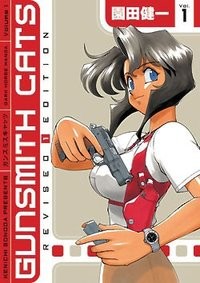
(by Kenichi Sonoda, Dark Horse Comics, $16.95 ea. Omnibus Edition)
Gunsmith Cats (written and drawn by Kenichi Sonoda, and released in the U.S. by Dark Horse) feels like one long tribute to the classic buddy-cop shows of old. Taking place in the far-off mystical land of Chicago—seriously, how crazy is it that such a place like Chicago ends up being such an inspired setting for a manga?—Gunsmith Cats is the story of Irene "Rally" Vincent and Minnie-May Hopkins. The former is a bounty hunter who moonlights as a gunsmith, the latter is her baby-faced, explosion-obsessed, ex-prostitute assistant. Together, they fight crime. Over the course of the story, many colorful and inspired friends and enemies pop in and out of their lives.
What really brings this all together is Sonoda's sense of spectacle: one minute, Rally is pitched in a fierce gunfight, demonstrating all sorts of feats with nothing but a handgun. The next, we're speeding down the freeway as Rally chases drug lords, smugglers, and kidnappers in her trusty Cobra GT 500. Even when there isn't any gunpowder or gasoline involved, there's always a proverbial bomb under someone's chair, forcing our heroines to keep on their toes. This is all complimented by Sonoda's artwork, although it drives an awkward balance between "cartoonish" and "realistic": the guns and cars are drawn with pain-staking detail, demonstrating the manga-ka's love and knowledge of the subject, but Sonoda makes a marked effort to demonstrate what happens when a .45 bullet hits someone's thumb. Some might find all of that in contrast with the cartoonish designs: Rally is big-eyed and stylized, and Minnie-May strikes dangerously close to lolita territory, which might turn away some readers. Sonoda isn't afraid of toeing the line between "tasteful nudity" and
"needless cheesecake", either.
Gunsmith Cats also suffers from something of a non-ending: after a particularly climactic arc, it has another story arc that, fun as it is, comes off as filler, followed by one "resolution" chapter that simply serves as an excuse to stop writing.
It's rather telling that Gunsmith Cats was eventually continued in Gunsmith Cats: Burst—not because there were any loose threads, but because it still felt like there were adventures to be had, bounties to be caught, and bullets to be shot.
I'd also like to bring attention to the translation, courtesy of Dana Lewis and the inimitable Toren Smith. The text flows naturally to such extent that it's rather hard to believe it was translated at all. The jokes are sharp and witty, the threats feel intimidating, and there's a bare minimum of awkward dialogue. Kudos to Lewis and Smith for their work.
Gunsmith Cats is a phenomenal read. Dark Horse has re-released the series in a set of four omnibus volumes, which include its spiritual predecessor Riding Bean, a tie-in to the classic OVA of the same title. With its high-flying adventure, and memorable characters, Gunsmith Cats serves as the standard that action stories should aspire to.
Strongly recommended, however, the violence and sexual content restricts this title to mature readers.
Is there a hidden gem of manga you'd like to reveal to the world? Is there a piece of garbage that deserves to be bashed in public? Or is there a title that didn't get a fair grade here, and you want to set the record straight?
Now's YOUR chance to be the reviewer! Write a review of about 300-400 words (a little more or less is fine) and include:
- your name.
- Title of manga (and volume no., if applicable)
- Author/Artist
- Publisher
- Briefly describe the story, then explain why this manga is great, terrible, or in between. Be objective, but also be entertaining.
Then send it in to rtoreaders (at) gmail (dot) com (plain text format preferred). One review will be selected out of all the submissions and will be published in the next column. All types of manga and manga-inspired comickry are accepted, from past and present, from Japan and beyond—what matters is that it's the Reader's Choice! NOTE: Submissions may be edited for formatting and grammar.
discuss this in the forum (16 posts) |